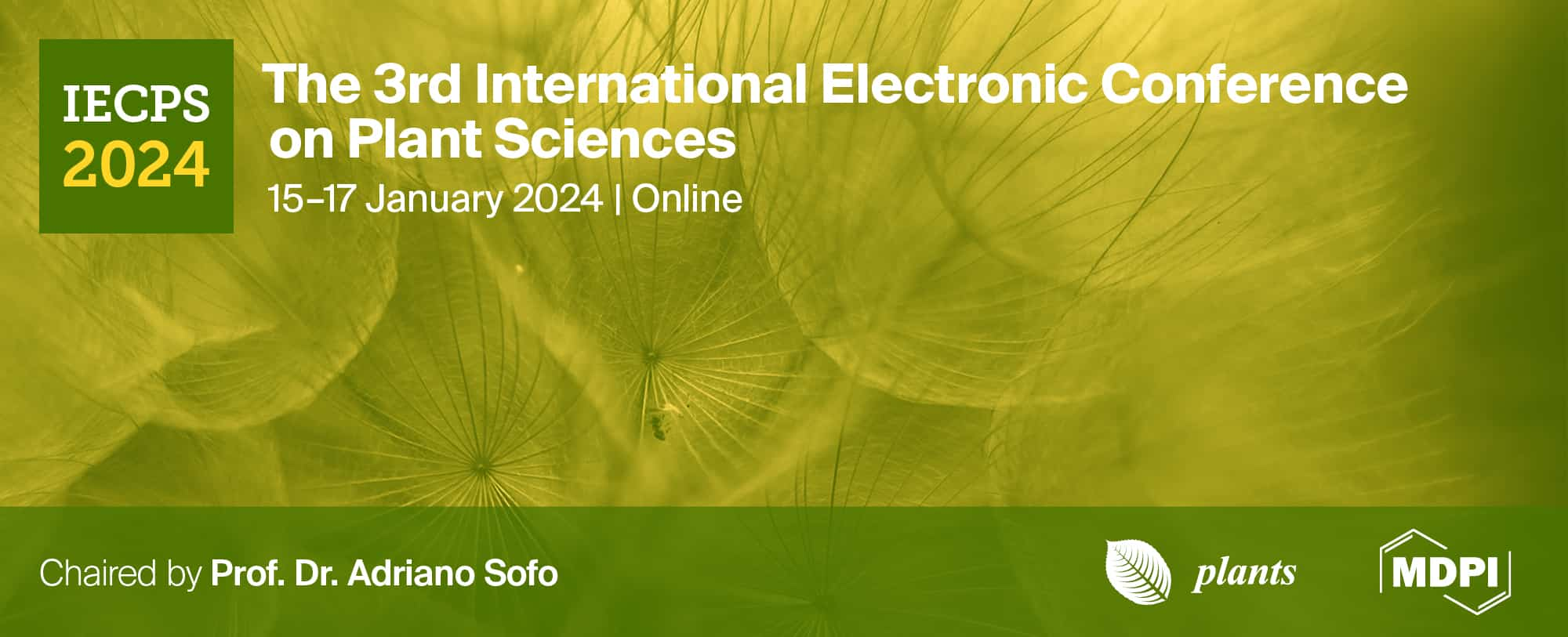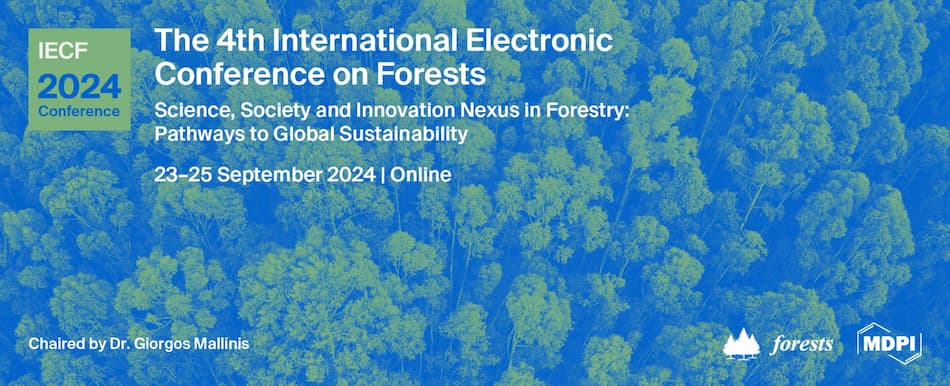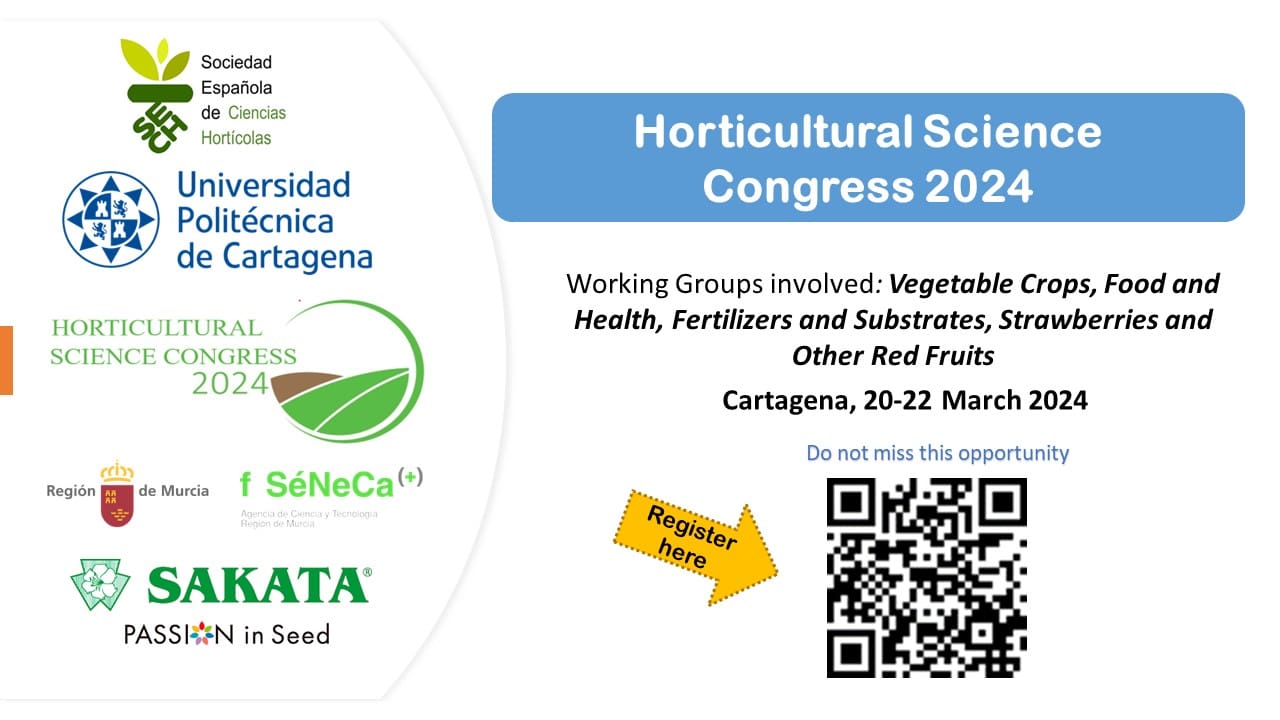-
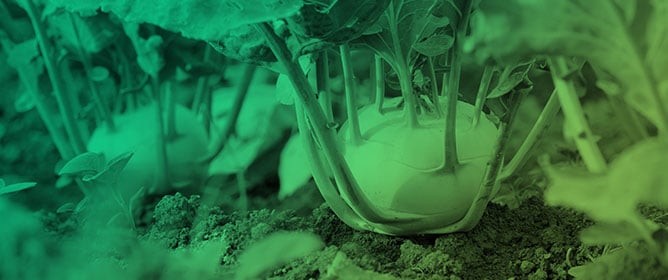 Plant Growth Promoting Bacteria for Aquaponics as a New Strategy That Grants Quality and Nutrient Efficiency in Kohlrabi Cultivation
Plant Growth Promoting Bacteria for Aquaponics as a New Strategy That Grants Quality and Nutrient Efficiency in Kohlrabi Cultivation -
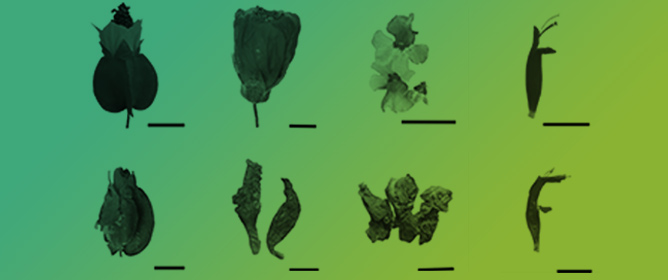 Effect of Drying Post-Harvest on the Nutritional Compounds of Edible Flowers
Effect of Drying Post-Harvest on the Nutritional Compounds of Edible Flowers -
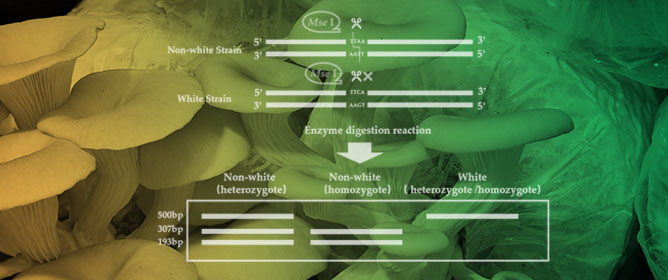 Development of Cleaved Amplified Polymorphic Sequence Marker for Cap Color Identification in Pleurotus cornucopiae
Development of Cleaved Amplified Polymorphic Sequence Marker for Cap Color Identification in Pleurotus cornucopiae -
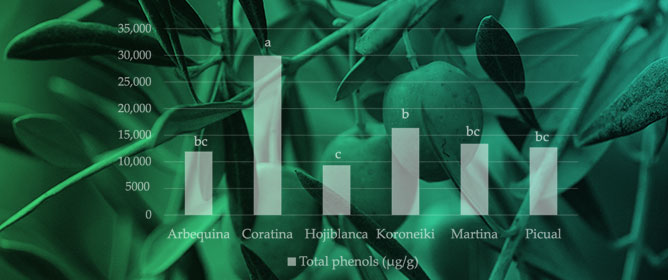 Influence of Genotype and Environment on Fruit Phenolic Composition of Olive
Influence of Genotype and Environment on Fruit Phenolic Composition of Olive
Journal Description
Horticulturae
Horticulturae
is an international, peer-reviewed, open access journal published monthly online by MDPI. The Spanish Society of Horticultural Sciences (SECH) is affiliated with Horticulturae and its members receive a discount on the article processing charges.
- Open Access— free for readers, with article processing charges (APC) paid by authors or their institutions.
- High Visibility: indexed within Scopus, SCIE (Web of Science), PubAg, AGRIS, FSTA, and other databases.
- Journal Rank: JCR - Q1 (Horticulture) / CiteScore - Q2 (Horticulture)
- Rapid Publication: manuscripts are peer-reviewed and a first decision is provided to authors approximately 14.7 days after submission; acceptance to publication is undertaken in 2.6 days (median values for papers published in this journal in the second half of 2023).
- Recognition of Reviewers: reviewers who provide timely, thorough peer-review reports receive vouchers entitling them to a discount on the APC of their next publication in any MDPI journal, in appreciation of the work done.
Impact Factor:
3.1 (2022);
5-Year Impact Factor:
3.4 (2022)
Latest Articles
Exploring MicroRNAs Associated with Pomegranate Pistil Development: An Identification and Analysis Study
Horticulturae 2024, 10(1), 85; https://doi.org/10.3390/horticulturae10010085 (registering DOI) - 16 Jan 2024
Abstract
The interaction between miRNAs (microRNAs) and target genes plays an important role in plant pistil development. MiRNAs related to pistils were explored in pomegranate. The differentially expressed miRNAs were screened at different developmental stages of pomegranate pistils, and their target differentially expressed mRNAs
[...] Read more.
The interaction between miRNAs (microRNAs) and target genes plays an important role in plant pistil development. MiRNAs related to pistils were explored in pomegranate. The differentially expressed miRNAs were screened at different developmental stages of pomegranate pistils, and their target differentially expressed mRNAs were further identified to clarify the regulatory effect of miRNAs on pistil development. In our study, 61 conserved miRNAs were identified in 30 families, including miR395, miR394, miR393, miR161, miR162, and miR168. Among them, miR156, miR157, miR159, miR160, miR164, miR165, miR166, miR167, miR169, and miR172 were involved in the development of flower organs. Eight miRNAs were randomly selected and verified for qRT-PCR analysis. The result analysis indicated that miR160, miR164, and miR172 might be positive factors in the regulation of pomegranate pistil development. MiR156 and miR166 might be involved in regulation of pomegranate pistil development as negative factors.
Full article
(This article belongs to the Special Issue Research on Pomegranate Germplasm, Breeding, Genetics and Multiomics)
►
Show Figures
Open AccessArticle
Mediator Subunit RhMED15a Regulates Drought Tolerance in Rose
Horticulturae 2024, 10(1), 84; https://doi.org/10.3390/horticulturae10010084 - 15 Jan 2024
Abstract
Mediator is a multiprotein complex integral to the transcription machinery, mediated by RNA polymerase II. Some Mediator subunits have been found to have critical functions in plants’ responses to abiotic stresses. However, the role of plant Mediator subunits in drought responses remains largely
[...] Read more.
Mediator is a multiprotein complex integral to the transcription machinery, mediated by RNA polymerase II. Some Mediator subunits have been found to have critical functions in plants’ responses to abiotic stresses. However, the role of plant Mediator subunits in drought responses remains largely enigmatic. Here, we identified a Mediator subunit, RhMED15a, in roses (Rosa hybrida). Its expression was greatly and swiftly induced by dehydration treatment in the root. The promoter sequence of RhMED15a contains cis-acting elements that respond to abscisic acid (ABA) and methyl jasmonate (MeJA). In addition, the expression of RhMED15a was significantly up-regulated with ABA treatment and inversely down-regulated with MeJA treatment. Silencing RhMED15a using virus-induced gene silencing (VIGS) in roses significantly reduced drought tolerance in rose plants. This resulted in a significant increase in the malondialdehyde (MDA) level and a decreased survival rate in comparison to TRV controls. Moreover, we found that the expression of five drought-related genes, including dehydration responsive element binding factor 1B (DREB1B), responsive to desiccation stress 29A (RD29A), responsive to desiccation stress 29B (RD29B), early response to dehydration 14 (ERD14), and 9-cis-epoxycarotenoid dioxygenase 1 (NCED1), was considerably suppressed in RhMED15a-silenced plants during drought stress. Taken together, our results present that the Mediator tail module subunit RhMED15a serves as an enhancer of drought tolerance in rose, probably through the modulation of the expression of some drought-related genes.
Full article
(This article belongs to the Special Issue Studies on Biotic and Abiotic Stress Responses of Horticultural Plants)
►▼
Show Figures
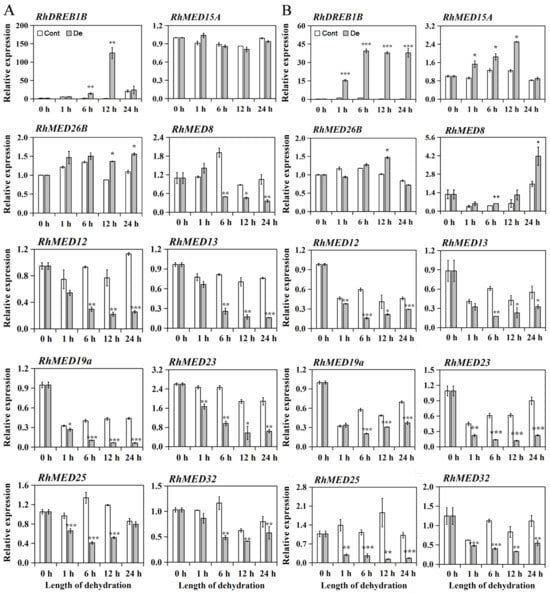
Figure 1
Open AccessArticle
Comparative Analysis of TPR Gene Family in Cucurbitaceae and Expression Profiling under Abiotic Stress in Cucumis melo L.
Horticulturae 2024, 10(1), 83; https://doi.org/10.3390/horticulturae10010083 - 15 Jan 2024
Abstract
Tetratricopeptide repeat (TPR) proteins play numerous roles in plant growth and development by mediating protein–protein interactions in biological systems by binding to peptide ligands. Although genome-wide analyses of the TPR gene family in other species have been performed, its evolution and function in
[...] Read more.
Tetratricopeptide repeat (TPR) proteins play numerous roles in plant growth and development by mediating protein–protein interactions in biological systems by binding to peptide ligands. Although genome-wide analyses of the TPR gene family in other species have been performed, its evolution and function in Cucurbitaceae remain unclear. In this study, 144 TPR genes from 11 genomes of eight Cucurbitaceae species with a heterogeneous distribution on the chromosomes were characterized. Based on the homology between Cucurbitaceae and Arabidopsis, the TPR genes were divided into four groups, and the evolutionary relationships of the Benincaceae and Cucurbitaceae tribes were also represented in a phylogenetic tree. Using the ‘DHL92′ genome as a reference, an integrated chromosome map was obtained containing 34 loci, 4 of which were common to the Cucurbitaceae. Cis-regulatory element analysis showed that these elements are essential for melon development and responses to light, phytohormones, and various stresses. CmTPR tissue- and development-specific expression analysis revealed differential expression patterns under normal growth conditions. Furthermore, the CmTPR genes responded to various abiotic stressors. Overall, this study offers insights into the evolutionary history of the TPR gene family in Cucurbitaceae and provides valuable information for elucidating the potential role of CmTPR genes during development and under different stresses in melon.
Full article
(This article belongs to the Special Issue Genome-Wide Identification and Expression Analysis for the Genetic Improvement of Horticultural Plants)
►▼
Show Figures
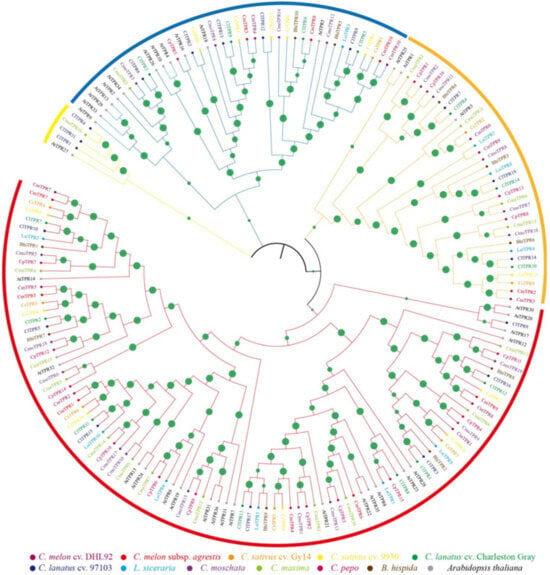
Figure 1
Open AccessArticle
A New Approach for Element Characterization of Grapevine Tissue with Laser-Induced Breakdown Spectroscopy
Horticulturae 2024, 10(1), 82; https://doi.org/10.3390/horticulturae10010082 - 15 Jan 2024
Abstract
The determination of grape quality parameters is intricately linked to the mineral composition of the fruit; this relationship is increasingly affected by the impacts of climate change. The conventional chemical methodologies employed for the mineral quantification of grape tissues are expensive and impracticable
[...] Read more.
The determination of grape quality parameters is intricately linked to the mineral composition of the fruit; this relationship is increasingly affected by the impacts of climate change. The conventional chemical methodologies employed for the mineral quantification of grape tissues are expensive and impracticable for widespread commercial applications. This paper utilized Laser-Induced Breakdown Spectroscopy (LIBS) to analyze the mineral constituents within the skin, pulp, and seeds of two distinct Vitis vinifera cultivars: a white cultivar (Loureiro) and a red cultivar (Vinhão). The primary objective was to discriminate the potential variations in the calcium (Ca), magnesium (Mg), and nitrogen (N) concentrations and water content among different grape tissues, explaining their consequential impact on the metabolic constitution of the grapes and, by extension, their influence on various quality parameters. Additionally, the study compared the mineral contents of the white and red grape cultivars across three distinct time points post veraison. Significant differences (p < 0.05) were observed between the Loureiro and Vinhão cultivars in Ca concentrations across all the dates and tissues and for Mg in the skin and pulp, N in the pulp and seeds, and water content in the skin and pulp. In the Vinhão cultivar, Ca differences were found in the pulp across the dates, N in the seeds, and water content in the skin, pulp, and seeds. Comparing the cultivars within tissues, Ca exhibited differences in the pulp, Mg in the skin and pulp, N in the pulp and seeds, and water content in the skin, pulp, and seeds. These findings provide insights into the relationship between the grape mineral and water content, climatic factors, and viticulture practices within a changing climate.
Full article
(This article belongs to the Topic Grapevine Facing Climate Change: From Land, through Plants to Grapes and Wine)
►▼
Show Figures
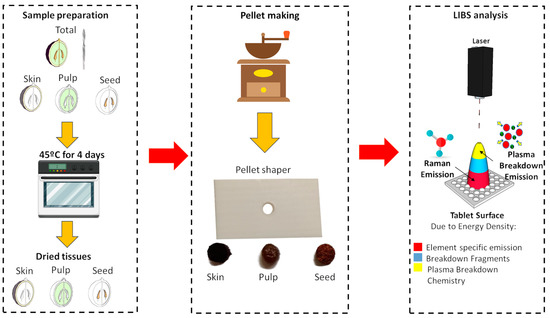
Figure 1
Open AccessArticle
Diversity of Crithmum maritimum L. from Salento Coastal Area: A Suitable Species for Domestication
by
, , , , and
Horticulturae 2024, 10(1), 81; https://doi.org/10.3390/horticulturae10010081 - 14 Jan 2024
Abstract
Crithmum maritimum L., known as sea fennel, is an aromatic halophyte typical of the cliffs and coastal areas of the Mediterranean Sea and Atlantic Ocean. Their phytochemicals have been of great interest in the food and pharmaceutical industry. In this work, we analyzed,
[...] Read more.
Crithmum maritimum L., known as sea fennel, is an aromatic halophyte typical of the cliffs and coastal areas of the Mediterranean Sea and Atlantic Ocean. Their phytochemicals have been of great interest in the food and pharmaceutical industry. In this work, we analyzed, by SPME/gas chromatography coupled with mass spectrometry, the chemical variability of C. maritimum accessions in terms of volatile organic compounds. C. maritimum seeds were collected from different coastal sites in Salento, Southern Apulia, Italy, and subsequently cultivated ex situ. Several volatile compounds produced by C. maritimum leaves were detected, and, among them, D-limonene was found to be emitted at high levels by plants of all accessions representing the main compound, while other monoterpenes were produced at low levels. Moreover, the phenylpropene volatiles dillapiol and apiol (designated together as (dill)apiol) were emitted at variable amounts with different accessions. The correlation among groups based on volatile compounds has been analyzed using hierarchical cluster analysis, which has revealed three main groups based on (dill)apiol presence and its total amount in the cultivated plants of different geographic origins, confirming intraspecies biodiversity. Moreover, we have evaluated the seed germination and seedling development of C. maritimum in controlled conditions. We found no dormancy and a high germination rate for all samples analyzed. The chemo-diversity evidenced in cultivated plants obtained from seeds collected at different locations on the Salento peninsula is probably related to variations in climate resulting from different exposures along the coast. These findings highlighted the importance of C.maritimum as a suitable candidate for cultivation because it can tolerate harsh conditions/stresses and also has a possible use besides food and pharmaceuticals and for the restoration of coastal environments.
Full article
(This article belongs to the Topic Mediterranean Biodiversity)
►▼
Show Figures
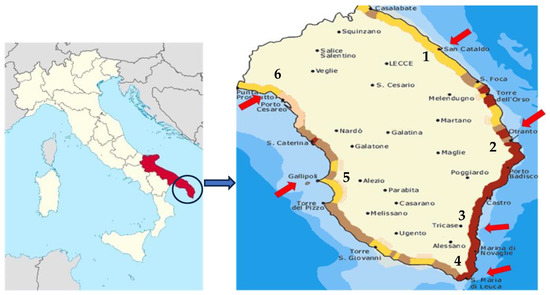
Figure 1
Open AccessArticle
Chitosan Coating Incorporated with Carvacrol Improves Postharvest Guava (Psidium guavaja) Quality
Horticulturae 2024, 10(1), 80; https://doi.org/10.3390/horticulturae10010080 - 14 Jan 2024
Abstract
Guava (Psidium guajava L.) is an important economic crop grown widely in tropical and subtropical regions. Guava exhibits fast ripening and senescence as a climacteric fruit, causing a short shelf life and quality deterioration. Chitosan–essential oil nanoemulsions can be an edible coating
[...] Read more.
Guava (Psidium guajava L.) is an important economic crop grown widely in tropical and subtropical regions. Guava exhibits fast ripening and senescence as a climacteric fruit, causing a short shelf life and quality deterioration. Chitosan–essential oil nanoemulsions can be an edible coating used to improve postharvest quality attributes. In this study, chitosan was mixed with carvacrol to generate a nano-emulsoid solution containing 0.1 and 0.2% (v/v) carvacrol, using a sonic dismembrator. Guava fruit were coated with the above emulsion and postharvest quality parameters were measured during storage at 20 ± 1 °C and RH = 80 ± 5% for 8 days. The result illustrated that the particle size of the chitosan–carvacrol emulsions was nanoscale, and their high stability was demonstrated by the zeta potential and polydispersity index. Chitosan coating (2%, w/v, 310–375 kDa) containing 0.2% (v/v) carvacrol maintained postharvest quality compared to chitosan alone, with higher firmness, soluble solid content, total acid, and total phenol content, and lower weight loss and pericarp browning. The collective data were further verified by principal component analysis. A chitosan coating containing carvacrol can reduce postharvest losses. It can be applied as an effective strategy to improve postharvest fruit quality.
Full article
(This article belongs to the Special Issue Recent Advancements in Postharvest Fruit Quality and Physiological Mechanism)
►▼
Show Figures
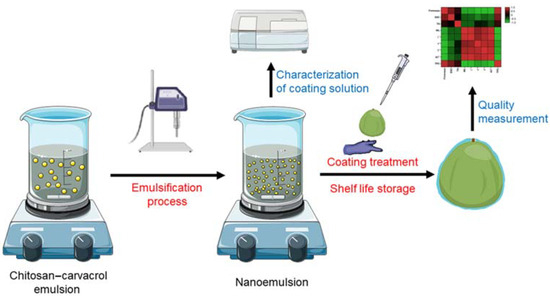
Figure 1
Open AccessArticle
Cucumber Auxin Response Factor CsARF10a Regulates Leaf Morphogenesis and Parthenocarpic Fruit Set in Tomato
by
, , , , , , , , , , , and
Horticulturae 2024, 10(1), 79; https://doi.org/10.3390/horticulturae10010079 - 12 Jan 2024
Abstract
Auxin response factors (ARFs) are pivotal transcription factors involved in many aspects of auxin-dependent developmental processes. While functions of ARFs have been extensively studied in Arabidopsis, their distinct role in cucumber remains unclear. In this study, a cucumber auxin response factor homolog, CsARF10a
[...] Read more.
Auxin response factors (ARFs) are pivotal transcription factors involved in many aspects of auxin-dependent developmental processes. While functions of ARFs have been extensively studied in Arabidopsis, their distinct role in cucumber remains unclear. In this study, a cucumber auxin response factor homolog, CsARF10a, was cloned and overexpressed in tomato plants. RT-qPCR analysis indicated that the expression abundance of CsARF10a was significantly decreased in cucumber leaves and female flowers, and the expression level of CsARF10a was relatively low in pollinated fruits and hormone-treated fruits compared with that in unpollinated fruits. Moreover, the overexpression of CsARF10a in tomato resulted in multiple phenotypic changes, including a wider leaf blade, delayed fruit ripening, and parthenocarpic fruit set in CsARF10a-OE lines. Taken together, our research shed light on the regulatory importance of CsARF10a in regulating various phenotype alterations and laid a solid foundation for further functional studies.
Full article
(This article belongs to the Section Genetics, Genomics, Breeding, and Biotechnology (G2B2))
►▼
Show Figures
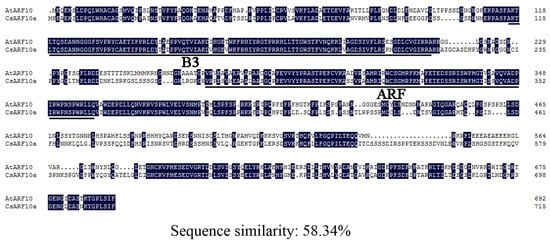
Figure 1
Open AccessArticle
Regeneration of African Violet in Response to Light Quality
Horticulturae 2024, 10(1), 78; https://doi.org/10.3390/horticulturae10010078 - 12 Jan 2024
Abstract
Light-emitting diode (LED) technology is a form of artificial lighting that offers precise control over spectral composition, creating specific conditions for plant growth and development. However, the influence of various LED wavelengths on the regeneration characteristics in African violet (AV) has not been
[...] Read more.
Light-emitting diode (LED) technology is a form of artificial lighting that offers precise control over spectral composition, creating specific conditions for plant growth and development. However, the influence of various LED wavelengths on the regeneration characteristics in African violet (AV) has not been extensively explored. This study aims to investigate the changes in the regeneration traits of AV when exposed to different LED light colors within controlled conditions. In this study, AV leaf cuttings were prepared and subjected to white, red, blue, and red + blue light colors for a period of three months in a growth chamber. Afterward, they were transferred to the laboratory for further analysis. The results indicated that the AVs treated with red + blue colors exhibited the most significant improvement in several morpho-physiological traits of both the roots and shoots. The highest total biomass (2.96 g), shoot fresh weight (1.76 g), root dry weight (0.14 g), root volume (3.10 cm3), and shoot length (1.60 cm) were observed in this treatment group. Furthermore, the highest levels of photosynthetic pigments, such as chlorophyll a, chlorophyll b, and carotenoids (0.14, 0.12, and 3.80 mg g−1 f.w., respectively), were predominantly observed in the red + blue treatment group. In conclusion, this study introduces a novel methodology for optimizing lighting conditions to enhance the regeneration of African violets, shedding light on the potential for improving AV regeneration practices.
Full article
(This article belongs to the Special Issue Seed Germination and Micropropagation of Ornamental Plants)
►▼
Show Figures
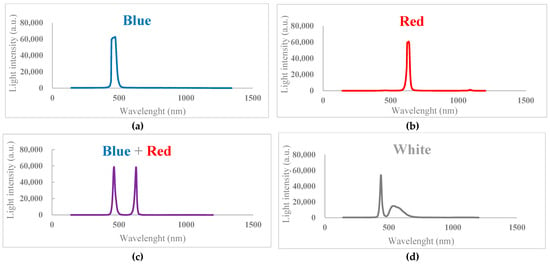
Figure 1
Open AccessTechnical Note
Development and Evaluation of a Web Application for Attracting Bees to Your Garden
Horticulturae 2024, 10(1), 77; https://doi.org/10.3390/horticulturae10010077 - 12 Jan 2024
Abstract
An online application called BeeGardens was developed for users to quickly access over 85 bee-friendly plants that attract 12 primary bee groups and ways to incorporate these into different landscape designs. The functionality and usefulness of the app was evaluated by students enrolled
[...] Read more.
An online application called BeeGardens was developed for users to quickly access over 85 bee-friendly plants that attract 12 primary bee groups and ways to incorporate these into different landscape designs. The functionality and usefulness of the app was evaluated by students enrolled in two courses: Florida Native Landscaping or Annual and Perennial Gardening, taught in different semesters. Before and after the semester, students were asked to report their perceived confidence to (1) identify bee-friendly plants, (2) identify bee pollinators, and (3) design a bee-friendly garden, using a Likert scale with responses ranging from 1 (strongly disagree) to 5 (strongly agree). Means of pre- and post-test self-reported responses showed a significant confidence gain upon using the BeeGardens online application in both courses. Students in Annual and Perennial Gardening and Florida Native Landscaping were 1.26 and 1.34 times, respectively, more confident in their ability to identify pollinator plants, identify bee pollinators, and design bee gardens after using the web application. These data were consistent with pre- and post-tested means where students were asked to identify three major pollinator plants and three major pollinators using multiple choice response options. Test scores increased by 26.3% and 37.9% in Annual and Perennial Gardening and Florida Native Landscaping, respectively. The majority of students (95.0%) agreed or strongly agreed this learning tool was organized, easy to navigate, and would use it in the future. Since its launch in 2021, BeeGardens has averaged 1201 unique visits per month, revealing its popularity and wide use.
Full article
(This article belongs to the Special Issue Outreach, Extension, and Education to Disseminate Horticultural Advances)
►▼
Show Figures
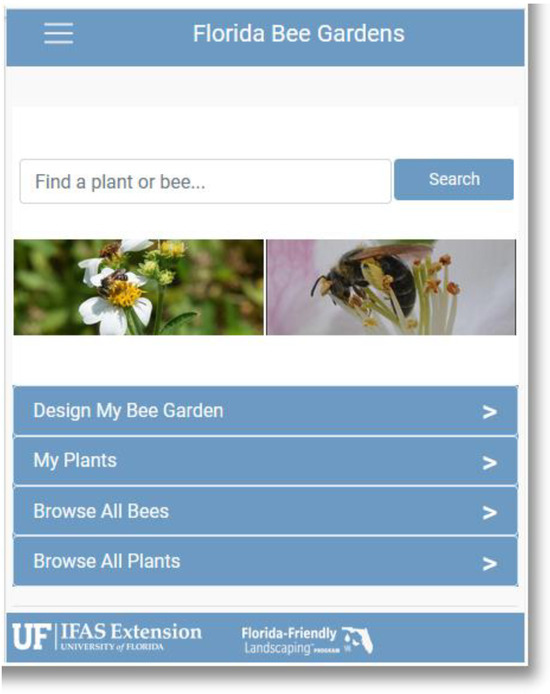
Figure 1
Open AccessArticle
Effect of Red and Blue Light on the Growth and Antioxidant Activity of Alfalfa Sprouts
Horticulturae 2024, 10(1), 76; https://doi.org/10.3390/horticulturae10010076 - 12 Jan 2024
Abstract
Alfalfa sprouts are popular as a gourmet vegetable that contains a variety of antioxidants with anti-cancer and anti-coronary heart disease properties. In this study, under a photosynthetic photon flux density (PPFD) of 30 mol·L−1 photoperiod of 12 h for 3 days, and
[...] Read more.
Alfalfa sprouts are popular as a gourmet vegetable that contains a variety of antioxidants with anti-cancer and anti-coronary heart disease properties. In this study, under a photosynthetic photon flux density (PPFD) of 30 mol·L−1 photoperiod of 12 h for 3 days, and a temperature of 25 ± 2 °C, we investigated the effects of different light qualities on the growth, nutritional quality and antioxidant activity of alfalfa sprouts by modulating LEDs with different red and blue ratios, and searched for suitable light-quality conditions for alfalfa sprout growth. The experimental results showed that the dark treatment favored the growth of alfalfa sprout hypocotyls and the increase of soluble sugar content; alfalfa fresh weight was the largest under the white and red light treatments; nitrate content was the lowest in the treatment with a red-to-blue ratio of 2:2 (2R2B); soluble proteins and total phenolic content were the highest in the treatment with red-to-blue ratio of 1:3 (1R3B); and the total antioxidant activity of sprouts was the highest in the blue light treatment.
Full article
(This article belongs to the Special Issue Breeding by Design: Advances in Vegetables)
►▼
Show Figures
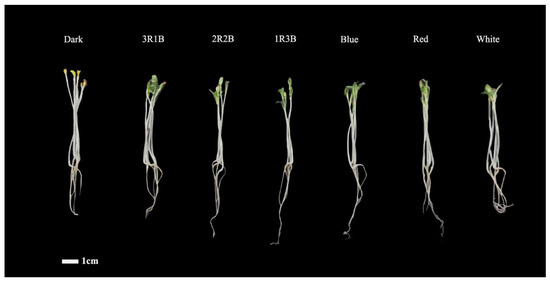
Figure 1
Open AccessArticle
Exploring the Feasibility of Integrating Weed and Nitrogen Management with Seed Meals in Organic Vegetables
Horticulturae 2024, 10(1), 75; https://doi.org/10.3390/horticulturae10010075 - 11 Jan 2024
Abstract
Corn gluten meal (CGM) and soybean meal (SBM) have demonstrated value as bioherbicides and organic fertilizers, but suggested application rates usually target either weed suppression or crop nutrition, not both. The objective of this study was to explore the feasibility of integrating weed
[...] Read more.
Corn gluten meal (CGM) and soybean meal (SBM) have demonstrated value as bioherbicides and organic fertilizers, but suggested application rates usually target either weed suppression or crop nutrition, not both. The objective of this study was to explore the feasibility of integrating weed and nitrogen management by evaluating effects of increasing seed meal rates within planting holes of plastic mulch film on weed density, soil nitrogen availability, and crop yield in tomato (Solanum lycopersicum) and broccoli (Brassica oleracea). CGM (10% N) or SBM (7% N) were applied at rates of 0.5, 1, 2, 3.5, or 5 g planting hole−1 N (depending on crop and year) after crops were transplanted, and 40 weed seeds per planting hole were seeded. Weed density decreased with increasing seed meal rate, regardless of type, and velvetleaf (Abutilon theophrasti) was more susceptible than the grass weeds tested. Velvetleaf suppression at the 5 g planting hole−1 N rate ranged from 66% to 97%, relative to the weedy control. Soil nitrogen availability increased with the application rate, but ammonium mineralized from seed meals applied at the highest rates were likely phytotoxic to weeds and crops. Seed meals never increased the crop yield and reduced the tomato yield in 2018 by 39% to 64%, relative to the weed-free control. The results suggest that integrating the management of weeds and nitrogen with seed meals in plastic mulch planting holes is not feasible because application rates required for consistent weed suppression are also toxic to crops.
Full article
(This article belongs to the Special Issue Organic Fertilizers in Horticulture)
►▼
Show Figures

Figure 1
Open AccessArticle
Bioavailability of Cd in Plantago weldenii and Sonchus oleraceus Plants: The Effects of a Humic and Fulvic Acids-Based Biostimulant
Horticulturae 2024, 10(1), 74; https://doi.org/10.3390/horticulturae10010074 - 11 Jan 2024
Abstract
Cadmium (Cd) contamination poses a major threat to plants and human health, as well as to ecosystem services. Biostimulants provide a promising eco-friendly solution to enhance the phytoremediation of Cd-contaminated soils. We examined the influence of a humic and fulvic acids-based biostimulant on
[...] Read more.
Cadmium (Cd) contamination poses a major threat to plants and human health, as well as to ecosystem services. Biostimulants provide a promising eco-friendly solution to enhance the phytoremediation of Cd-contaminated soils. We examined the influence of a humic and fulvic acids-based biostimulant on two plant species, e.g., Plantago weldenii and Sonchus oleraceus (common sowthistle), in a soil spiked with Cd at 45 mg kg−1. The aim of this study was to determine whether a biostimulant can potentially affect Cd mobility in soil and absorption in plant tissues. We found that the biostimulant significantly decreased Cd bioavailability (recorded as DTPA extractability) in the soil where Plantago was grown from 17.57 to 13.12 mg kg−1, probably due to the Cd immobilization effect of the added biostimulant. However, the biostimulant had the opposite effect in the soil where S. oleraceus was grown (Cd-DTPA significantly increased from 10.13 to 13.03 mg kg−1). S. oleraceus was found to have accumulated higher Cd concentrations in its aerial parts, resulting in a soil-to-plant transfer value close to 1 and root-to-shoot translocation value well above 1. These two indices exhibited the potential of S. oleraceus to be used as hyperaccumulator in Cd-contaminated soils, while P. weldenii behaved rather as a Cd excluder. These findings highlight the complex dynamics of added biostimulants and Cd behavior in soil and plants. We recognize the need for further research so that the mechanisms dictating Cd behavior after biostimulant application can be better elucidated.
Full article
(This article belongs to the Special Issue Biostimulants Application in Horticultural Crops)
►▼
Show Figures
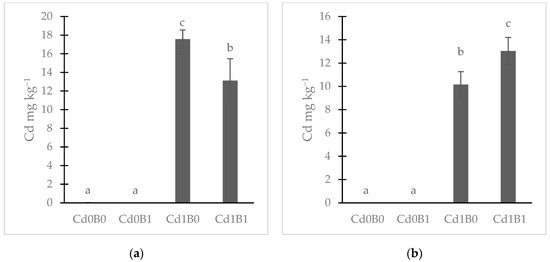
Figure 1
Open AccessFeature PaperArticle
Study on Italian Onion Cultivars/Ecotypes towards Onion Yellow Dwarf Virus (OYDV) Infection
by
, , , , , and
Horticulturae 2024, 10(1), 73; https://doi.org/10.3390/horticulturae10010073 - 11 Jan 2024
Abstract
The onion yellow dwarf virus (OYDV) represents a limiting biotic stress in onion (Allium cepa L.); little information is available regarding resistant varieties. In Italy, onion production is limited but represented by a wide diversity of ecotypes. A two-year trial was carried
[...] Read more.
The onion yellow dwarf virus (OYDV) represents a limiting biotic stress in onion (Allium cepa L.); little information is available regarding resistant varieties. In Italy, onion production is limited but represented by a wide diversity of ecotypes. A two-year trial was carried out to test the OYDV-susceptibility/tolerance of different Italian onion cultivars by rating symptom severity and plant growth parameters and assessing post-harvest secondary infections. The cultivar and ecotypes included in the study were characterized by simple sequence repeats (SSR) analysis, and the expression analysis of two genes (Eukaryotic translation initiation factors, EIFs) involved in potyvirus replication was also performed. Two susceptible and one tolerant cultivar were identified based on symptom expression and virus impact on plants. Although differences in growth parameters were limited to the first-year trial, the infection was correlated to a higher incidence of secondary infections in post-harvest, with altered water balance in infected bulbs. This correlation was also demonstrated during the long-term storage of bulbs. SSR analysis identified different clusters and only one gene isoform (EIF4eiso1) showed different expression levels in the OYDV/onion pathosystem. In conclusion, this study defines the genetic profile of Italian onion cultivars and provides evidence on susceptibility/tolerance features which will be useful in the future for the identification of viral resistance traits in onion.
Full article
(This article belongs to the Special Issue Plant Pathology in Horticultural Production)
►▼
Show Figures
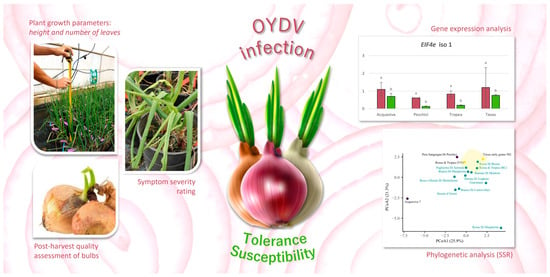
Graphical abstract
Open AccessArticle
Invertase Plays a Vital Role in Regulating Wound-Induced Accumulation of Phenolic Compounds in Carrot Tissue
Horticulturae 2024, 10(1), 72; https://doi.org/10.3390/horticulturae10010072 - 11 Jan 2024
Abstract
The application of wounding stress can induce the accumulation of phenolic antioxidants in carrots. This study aimed to investigate the possible regulation role of invertase (INV) on the biosynthesis of phenolics in wounded carrots. In this study, carrots were cut into two different
[...] Read more.
The application of wounding stress can induce the accumulation of phenolic antioxidants in carrots. This study aimed to investigate the possible regulation role of invertase (INV) on the biosynthesis of phenolics in wounded carrots. In this study, carrots were cut into two different wounding intensities of slices and cubes, then stored at 20 °C for 2 days. The results showed that wounding stress caused an obvious increase in phenolic content and antioxidant capacity in carrot tissues, and a positive correlation was observed between the biosynthesis of phenolic compounds and the degradation of sucrose. Simultaneously, wounding activated the sucrose-cleaving enzymes of INVs, including acid INV (AI) and neutral INV (NI), and up-regulated the expressions of most encoding genes of INVs. In addition, treatment with INV activators accelerated the accumulation of phenolic antioxidants, while treatment with INV inhibitors suppressed this process, suggesting that the synthesis of phenolic compounds in wounded carrots is closely related to the availability of sugars. Our findings provide new insights into the regulation role of INV on the wound-induced accumulation of phenolic compounds in carrots, which may be helpful in using wounded plants to produce more phenolic antioxidants.
Full article
(This article belongs to the Special Issue Postharvest Physiology and Quality Maintaining of Horticultural Plants)
►▼
Show Figures
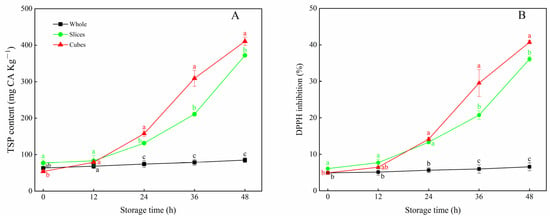
Figure 1
Open AccessArticle
Growth, Triterpene Glycosides, and Antioxidant Activities of Centella asiatica L. Urban Grown in a Controlled Environment with Different Nutrient Solution Formulations and LED Light Intensities
Horticulturae 2024, 10(1), 71; https://doi.org/10.3390/horticulturae10010071 - 10 Jan 2024
Abstract
Nutrients and light are critical factors for sustained Centella asiatica L. Urban production under a controlled environment. The growth, triterpene glycosides, and antioxidant activities of C. asiatica grown under a controlled environment with different nutrient solution formulations (NFFs) and LED light intensities were
[...] Read more.
Nutrients and light are critical factors for sustained Centella asiatica L. Urban production under a controlled environment. The growth, triterpene glycosides, and antioxidant activities of C. asiatica grown under a controlled environment with different nutrient solution formulations (NFFs) and LED light intensities were investigated. Four different NSFs were tested on plant growth, bioactive compounds, and their activities in a conventional greenhouse. The results showed that the plants grown with Houghland and Arnon solution exhibited better growth performance, whereas the use of Resh’s Tropical Dry Summer solution led to increased bioactive compounds and their activities. Subsequently, Resh’s Tropical Dry Summer solution was selected to evaluate the effect of light intensity in a controlled environment. Plants were grown under three LED light intensities (110, 220, and 330 µmol/m2/s PPFD) compared with fluorescent and natural lights (45 and 326 µmol/m2/s PPFD, respectively). We found that light intensity had the strongest influence on growth, triterpene glycosides, and antioxidant activities. Significantly higher values of the most studied parameters were observed in plants grown under high light intensity compared to those grown under low light intensity. The optimal light intensity was 330 µmol/m2/s PPFD, representing an efficient approach for commercially producing this medicinal plant with a higher yield and medicinal properties in a controlled environment.
Full article
(This article belongs to the Section Plant Nutrition)
►▼
Show Figures
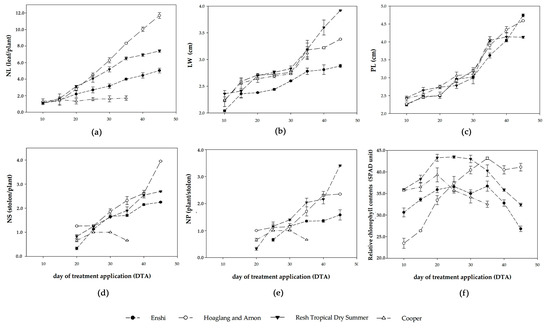
Figure 1
Open AccessArticle
An Innovative Co-Cultivation of Microalgae and Actinomycete-Inoculated Lettuce in a Hydroponic Deep-Water Culture System for the Sustainable Development of a Food–Agriculture–Energy Nexus
by
, , , , , , , , and
Horticulturae 2024, 10(1), 70; https://doi.org/10.3390/horticulturae10010070 - 10 Jan 2024
Abstract
In recent years, researchers have turned their attention to the co-cultivation of microalgae and plants as a means to enhance the growth of hydroponically cultivated plants while concurrently producing microalgal biomass. However, the techniques used require precise calibration based on plant growth responses
[...] Read more.
In recent years, researchers have turned their attention to the co-cultivation of microalgae and plants as a means to enhance the growth of hydroponically cultivated plants while concurrently producing microalgal biomass. However, the techniques used require precise calibration based on plant growth responses and their interactions with the environment and cultivation conditions. This study initially focused on examining the impact of hydroponic nutrient concentrations on the growth of the microalga Chlorella sp. AARL G049. The findings revealed that hydroponic nutrient solutions with electrical conductivities (EC) of 450 µS/cm and 900 µS/cm elicited a positive response in microalgae growth, resulting in high-quality biomass characterized by an elevated lipid content and favorable properties for renewable biodiesel. The biomass also exhibited high levels of polyunsaturated fatty acids (PUFAs), indicating excellent nutritional indices. The microalgae culture and microalgae-free culture, along with inoculation-free lettuce (Lactuca sativa L. var. longifolia) and lettuce that was inoculated with plant growth actinobacteria, specifically the actinomycete Streptomyces thermocarboxydus S3, were subsequently integrated into a hydroponic deep-water culture system. The results indicated that several growth parameters of lettuce cultivated in treatments incorporating microalgae experienced a reduction of approximately 50% compared to treatments without microalgae, and lowering EC levels in the nutrient solution from 900 µS/cm to 450 µS/cm resulted in a similar approximately 50% reduction in lettuce growth. Nevertheless, the adverse impacts of microalgae and nutrient stress were alleviated through the inoculation with actinomycetes. Even though the co-cultivation system leads to reduced lettuce growth, the system enables the production of high-value microalgal biomass with exceptional biodiesel fuel properties, including superior oxidative stability (>13 h), a commendable cetane number (>62), and a high heating value (>40 MJ/kg). This biomass, with its potential as a renewable biodiesel feedstock, has the capacity to augment the overall profitability of the process. Hence, the co-cultivation of microalgae and actinomycete-inoculated lettuce appears to be a viable approach not only for hydroponic lettuce cultivation but also for the generation of microalgal biomass with potential applications in renewable energy.
Full article
(This article belongs to the Special Issue New Advances in Green Leafy Vegetables)
►▼
Show Figures
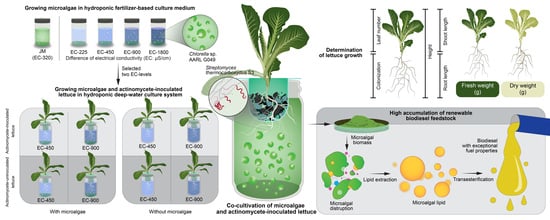
Graphical abstract
Open AccessArticle
Genotype-Specific Response to Silicon Supply in Young Tomato and Unripe Melon Plants Grown in a Floating System
by
, , , and
Horticulturae 2024, 10(1), 69; https://doi.org/10.3390/horticulturae10010069 - 09 Jan 2024
Abstract
Agronomic biofortification of crops is a promising approach for the accumulation of Si in plant organs and can be achieved through the application of Si-containing fertilizers in the nutrient solution (NS) using a soilless technique. In the present research, a local variety of
[...] Read more.
Agronomic biofortification of crops is a promising approach for the accumulation of Si in plant organs and can be achieved through the application of Si-containing fertilizers in the nutrient solution (NS) using a soilless technique. In the present research, a local variety of Cucumis melo L. called Carosello and two tomato hybrids, ‘Alfa 200’ (TA) and ‘Versus’ (TV), were cultivated in a floating system with three levels of Si (0, 50, and 100 mg·L−1) in the NS with the aim to study the Si translocation/accumulation in leaves, stems, and roots of these genotypes. In general, by adding Si to the NS, Si accumulation in plants increased. Regarding Si translocation, it was found that Carosello exhibited a better translocation capacity than tomato hybrids, and Si movement from roots to shoots was very much dependent on tomato genotypes. With the highest Si content in the NS, TA had a similar Si concentration in leaves and stems, while TV showed a greater Si concentration in leaves. In conclusion, Carosello landrace is confirmed as a good Si accumulator, while the tomato is confirmed as a species with low Si accumulation capacity. Nevertheless, the effectiveness of Si biofortification in tomatoes is very much dependent on the genotype.
Full article
(This article belongs to the Special Issue New Insights into Vegetable Biofortification)
►▼
Show Figures
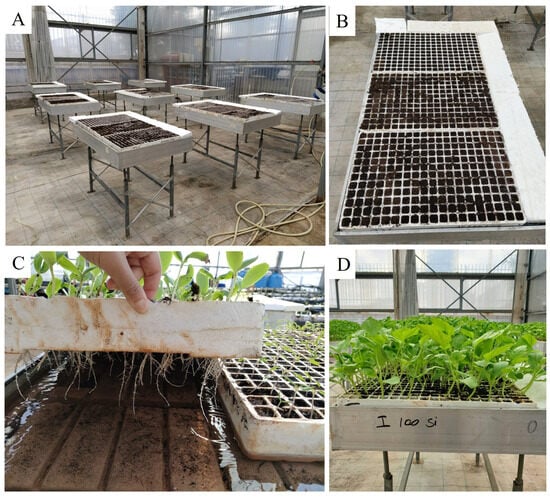
Figure 1
Open AccessArticle
Obtaining Spatial Variations in Cabernet Sauvignon (Vitis vinifera L.) Wine Flavonoid Composition and Aromatic Profiles by Studying Long-Term Plant Water Status in Hyper-Arid Seasons
Horticulturae 2024, 10(1), 68; https://doi.org/10.3390/horticulturae10010068 - 09 Jan 2024
Abstract
The spatial variability in vineyard soil might negatively affect wine composition, leading to inhomogeneous flavonoid composition and aromatic profiles. In this study, we investigated the spatial variability in wine chemical composition in a Cabernet Sauvignon (Vitis vinifera L.) vineyard in 2019 and
[...] Read more.
The spatial variability in vineyard soil might negatively affect wine composition, leading to inhomogeneous flavonoid composition and aromatic profiles. In this study, we investigated the spatial variability in wine chemical composition in a Cabernet Sauvignon (Vitis vinifera L.) vineyard in 2019 and 2020. Because of the tight relationships with soil profiles, mid-day stem water potential integrals (Ψstem Int) were used to delineate the vineyard into two zones, including Zone 1 with relatively higher water stress and Zone 2 with relatively lower water stress. Wine from Zone 2 generally had more anthocyanins in 2019. In 2020, Zone 1 had more anthocyanins and flavonols. Zone 2 had more proanthocyanidin extension and terminal subunits as well as total proanthocyanidins in 2020. According to the Principal Component Analyses (PCA) for berry and wine chemical composition, the two zones were significantly different in the studied wine aromatic compounds. In conclusion, this study provides evidence of the possibility of managing the spatial variability of both wine flavonoid composition and aromatic profiles through connecting vineyard soil variability to grapevine season-long water status.
Full article
(This article belongs to the Special Issue Precision Vineyard Management under Climate Change)
►▼
Show Figures
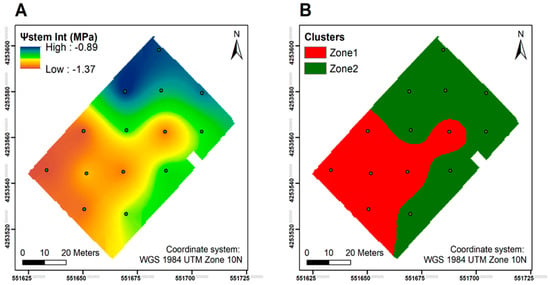
Figure 1
Open AccessArticle
Assessment of Phytotoxicity in Untreated and Electrochemically Treated Leachates through the Analysis of Early Seed Growth and Inductively Coupled Plasma-Optical Emission Spectroscopy Characterization
Horticulturae 2024, 10(1), 67; https://doi.org/10.3390/horticulturae10010067 - 09 Jan 2024
Abstract
The treatment of stabilized leachates with high refractory organic matter content, which are over 10 years old, presents a challenge. This study explored the potential of electro-coagulation (EC) and electro-oxidation (EO) treatment systems to address this issue. The objective of this study was
[...] Read more.
The treatment of stabilized leachates with high refractory organic matter content, which are over 10 years old, presents a challenge. This study explored the potential of electro-coagulation (EC) and electro-oxidation (EO) treatment systems to address this issue. The objective of this study was to investigate the phytotoxicity of the proposed treatment system on seed growth and examine possible relationships between phytotoxicity results and the characterization of leachates, effluents, soil, and radicles. Phytotoxicity tests were conducted on seeds of Lactuca sativa, Cucumis sativus, and Phaseolus vulgaris, using Inductively Coupled Plasma-Optical analysis. The evolution of organic matter was monitored by fractionating the chemical oxygen demand (COD) and humic substances. The biodegradability index increased from 0.094 in raw leachate to 0.26 and 0.48 with EC and EO, respectively. Removal rates of 82%, 86%, 99%, and 81% were achieved for COD, dissolved organic carbon, color, and ammoniacal nitrogen, respectively. The biodegradable COD increased from 26% in raw leachate to 39% in the EC process and 58% in the EO process effluent. The proposed treatment system successfully broke the aromatic structures of the humic substances present in the raw leachate, thereby increasing the content of biodegradable material. Phytotoxicity tests revealed that the proposed treatment system significantly reduced the phytotoxicity of the generated effluents.
Full article
(This article belongs to the Special Issue Advanced Studies in Abiotic Stress Response Mechanism of Horticultural Plants)
►▼
Show Figures
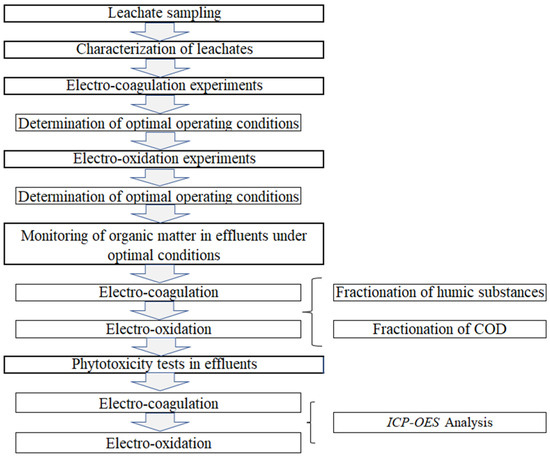
Figure 1
Open AccessArticle
RSM and ANN Modeling of Camelina (Camelina sativa L. Crantz) Seed Yield as Affected by Nitrogen, Sulfur, Cow Manure, and Row Spacing
Horticulturae 2024, 10(1), 66; https://doi.org/10.3390/horticulturae10010066 - 09 Jan 2024
Abstract
►▼
Show Figures
Camelina [Camelina sativa (L.) Crantz] is an annual versatile oilseed crop of the Brassicaceae family, with an increasingly cultivated area. Predicting camelina seed yield response to fertilization and planting density is of great importance in understanding production potential and management planning. Therefore,
[...] Read more.
Camelina [Camelina sativa (L.) Crantz] is an annual versatile oilseed crop of the Brassicaceae family, with an increasingly cultivated area. Predicting camelina seed yield response to fertilization and planting density is of great importance in understanding production potential and management planning. Therefore, the current study aimed to estimate the seed yield of camelina by response surface methodology (RSM) and artificial neural network (ANN) as affected by different levels of planting row spacing and nitrogen (N), sulfur (S), and cow manure (CM) fertilization. The experiment was conducted in two growing years of 2019–2020 and 2020–2021, based on a central composite design with four factors including row spacing (15–35 cm), N (0–200 kg ha−1), S (0–100 kg ha−1), and CM (0–40 t ha−1). The RSM models for seed yield versus fertilization and row spacing factors in both years were statistically significant and had an acceptable predictive ability. Camelina seed yield decreased with increasing row spacing but showed a positive response to increasing the amount of N, S, and CM fertilizers. Comparing the performance of the models showed that, although the RSM models were significant and had the necessary efficiency in predicting camelina seed yield, the ANN models were more accurate. The performance criteria of coefficient of determination (R2), root mean square error (RMSE), standard error of prediction (SEP), mean absolute error (MAE), and Akaike information criterion (AICc) averaged over the two years for the RSM model were 0.924, 51.60, 5.51, 41.14, and 394.05, respectively, and for the ANN model were 0.968, 32.62, 3.54, 19.55, and 351.33, respectively. Based on the results, the ANN modeling can be used in predicting camelina seed yield in field conditions with more confidence than the RSM technique.
Full article
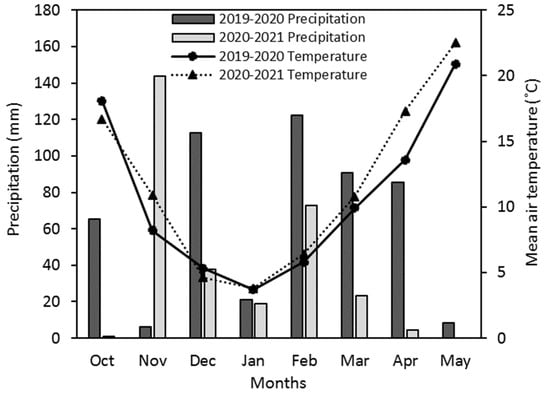
Figure 1

Journal Menu
► ▼ Journal Menu-
- Horticulturae Home
- Aims & Scope
- Editorial Board
- Reviewer Board
- Topical Advisory Panel
- Instructions for Authors
- Special Issues
- Topics
- Sections & Collections
- Article Processing Charge
- Indexing & Archiving
- Editor’s Choice Articles
- Most Cited & Viewed
- Journal Statistics
- Journal History
- Journal Awards
- Society Collaborations
- Conferences
- Editorial Office
Journal Browser
► ▼ Journal BrowserHighly Accessed Articles
Latest Books
E-Mail Alert
News
2 January 2024
MDPI Insights: The CEO's Letter #7 - Nobel Laureates Entrust MDPI with Their Research
MDPI Insights: The CEO's Letter #7 - Nobel Laureates Entrust MDPI with Their Research
27 December 2023
Horticulturae | Invitation to Read the 2022 Feature Papers in the Section “Vegetable Production Systems”
Horticulturae | Invitation to Read the 2022 Feature Papers in the Section “Vegetable Production Systems”
Topics
Topic in
Agriculture, Agronomy, Forests, Gastronomy, Grasses, Horticulturae, Sustainability
Mediterranean Biodiversity
Topic Editors: Luigi De Bellis, Genuario Belmonte, Massimiliano Renna, Elena Ciani, Monica Marilena Miazzi, Andrea PieroniDeadline: 29 February 2024
Topic in
Horticulturae, Plants, Agronomy, Agriculture, Sustainability
Soil Fertility and Plant Nutrition for Sustainable Agriculture
Topic Editors: Othmane Merah, Purushothaman Chirakkuzhyil Abhilash, Magdi T. Abdelhamid, Hailin Zhang, Bachar ZebibDeadline: 10 March 2024
Topic in
Sustainability, Agronomy, Agriculture, Foods, Horticulturae
New Trends in Agri-Food Sector: Environmental, Economic and Social Perspectives, 2nd Volume
Topic Editors: Riccardo Testa, Giuseppina Migliore, Giorgio Schifani, József TóthDeadline: 31 March 2024
Topic in
Agronomy, Horticulturae, IJPB, Life, Plants
Effects of Climate Change on Viticulture (Grape)
Topic Editors: Arif Atak, Andreia Figueiredo, Inmaculada Pascual, Fermin MoralesDeadline: 31 December 2024

Conferences
Special Issues
Special Issue in
Horticulturae
Green Roofs, Green Walls, Urban Greenhouses and Hi-Tech City Landscape for Sustainability
Guest Editors: Carlo Alberto Campiotti, Carlo Bibbiani, Arianna LatiniDeadline: 20 January 2024
Special Issue in
Horticulturae
Sustainable and Organic Farming of Vegetable Crops in Greenhouse and Open Field Systems
Guest Editor: Kalliopi KadoglidouDeadline: 30 January 2024
Special Issue in
Horticulturae
Storage and Quality Management of Horticultural Products
Guest Editor: Katarzyna PobiegaDeadline: 10 February 2024
Special Issue in
Horticulturae
Plants Response to Abiotic Stresses: Strategies for Adaptations and Survival
Guest Editor: Amith R. DevireddyDeadline: 20 February 2024
Topical Collections
Topical Collection in
Horticulturae
Postharvest Handling of Horticultural Crops
Collection Editors: Adriana Guerreiro, Maria Dulce Carlos Antunes, Custódia Maria Luís Gago
Topical Collection in
Horticulturae
New Challenges in Productivity of Berry Fruits
Collection Editors: Christopher M. Menzel, Anita Sønsteby
Topical Collection in
Horticulturae
New Advances in Fruit Quality: Pre-harvest Techniques and Postharvest Management
Collection Editors: Alessio Allegra, Giuseppe Sortino
Topical Collection in
Horticulturae
Recent Advances in Hydroponic and Aquaponic Research
Collection Editor: Michael Timmons



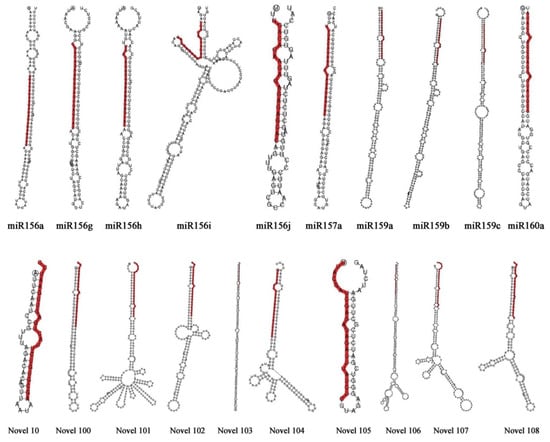






.JPG)





